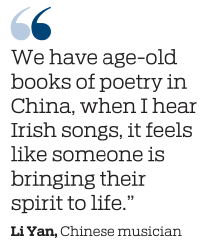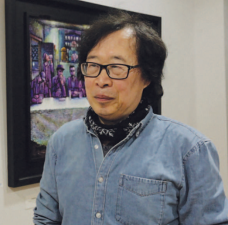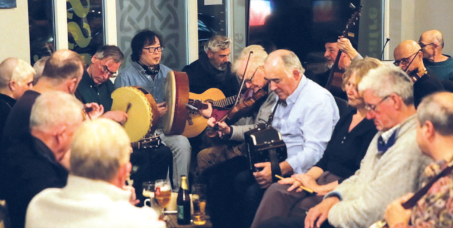Musician helps build cultural bridge between China and Ireland

China and Ireland may be more than 8,000 kilometers apart, and vastly different in geography and demographics, but there are some things that bind the countries together.
Both are famous for their expat communities, and the food and drink they have taken around the world.
Both are renowned for their artistic heritage, and when it comes to music, Ireland holds a particular fascination for China.
An example of this is Li Yan, a 65-year-old originally from Beijing, who lived in Zhangjiakou city in North China's Hebei province; Jinzhou city in Northeast China's Liaoning province; Luoyang city in Central China's Henan province; and Guangzhou city in South China's Guangdong province, before coming to London, where he is part of the city's vibrant Irish music scene.
His instrument is the bodhran, a goatskin drum played with a wooden beater that is an essential part of traditional Irish music.
On Thursday nights, he can be found in an Irish pub in Kingston upon Thames, playing with a group called Hungry Grass in a session, which is a social and musical gathering found wherever there are Irish communities around the world.
A session leader takes charge of musicians playing instruments such as the guitar, flute, violin or fiddle, as it is known in session culture, tin whistle, accordion, and bodhran. The session leader invites members to suggest songs to play.
On Friday nights, Li is a regular and popular member of another session, at the Irish Cultural Centre in Hammersmith, West London.
"My background is as a poet, not a musician," he told China Daily. "In China, I had a Canadian English teacher called Glen Allen, who introduced me to Irish culture, particularly its writers.
"When I came to London, I saw Hungry Grass play and was so attracted to the stories of their songs that I wanted to translate them, but I realized that to present the words in the right way, I must have some basic musical knowledge. With lyrics, it's not just about straight translation of words, they have to sit right with the music."
As with so many Irish stories, the turning point happened in a pub.
"Once, I was listening to Hungry Grass and drumming along on the table when an old Irishman told me I was doing it all wrong, and that I should learn how to play Irish music properly, so I looked up bodhran classes and found the Irish Cultural Centre."
Philip Cashin is the founder of the Friday night session group that performed for King Charles III when he visited the cultural center in March 2022. He rates Li's musicianship highly.
"When he first appeared, I was astonished," he said. "He started to sing a Gaelic song in Chinese, and he did it perfectly, I thought 'this is special, very special'."
Another session stalwart is Ben Gunnery, a former All Ireland Under-16 Fiddle champion who has traveled the world with numerous productions, including touring in China. "Whenever I play a session, I tell everyone else to shut up when he (Li) starts singing, because it's magical," he said.
Li is not the only person building this cultural connection. Gourd flute (hulusi) player Jaylin Chu has found online fame playing Irish music, even moving to Ireland to do a master's degree after being inspired by seeing the global sensation Riverdance as a teenager.
The world of academia is also doing its bit. In July 2024, the Confucius Institute at University College Dublin hosted a performance by the Jinan Children's Folk Music Ensemble from East China's Shandong province, after which the youngsters were taught the basics of traditional Irish dancing.
The following month, music students from Southwest University, in Southwest China's Chongqing municipality, spent two weeks at the Irish World Academy of Music and Dance at the University of Limerick, strengthening a cultural connection that predates China and Ireland even having diplomatic links.
In the early 1980s, Chinese embassy workers in London attended a concert by one of the most influential traditional Irish music groups of all time, The Chieftains, and were impressed.
Once the countries established ties, the music group's leader Paddy Moloney built connections by first inviting Chinese musicians and dancers from the Tianjin Ensemble in North China to play with The Chieftains at Dublin's National Concert Hall.
This paved the way for their historic visit in 1983, where The Chieftains performed in Beijing, Suzhou and Shanghai, and on the Badaling Great Wall. The tour finale in Shanghai was televised to an estimated audience of 700 million people.
In the group's official biography, Sun Sheng, vice-chairman of the Musicians' Association of China at that time, was quoted as saying: "I think through The Chieftains' music, I have seen the images of the Irish people. Music knows no boundaries for it is a unique and comprehensive language."
Two years later, The Chieftains released an album inspired by the trip and incorporating instruments from both musical cultures.
In 1994, there was another moment of creative connection, when the Riverdance phenomenon launched an updated version of traditional Irish dancing on the global stage.
While for some countries this was totally new, in China its popularity built on existing foundations, with dancers performing on the Great Wall in 2003 and subsequently making several tours to sell-out houses in several cities.
Last winter, Riverdance's 25th anniversary tour included a nine-week visit to China, with seven performances in the Shanghai Culture Square, eight at the theater of the Beijing Exhibition Center, and dates in 23 other cities. The rival show, Lord of the Dance, established by Riverdance's creator Michael Flatley, has also proved hugely popular, first being performed in Beijing in 2004, and being part of the opening gala of the Beijing International Horticultural Exhibition in 2019, as the Lord of the Dance Troupe of Ireland danced with Chinese schoolchildren who had studied Irish dancing.
The modern cultural link between China and Ireland is clear to see, but as Li points out, it is built on artistic similarities that date back many centuries.
"We have a long drumming tradition in China, going back to ancient times, so when I hear the bodhran, it feels part of that tradition," Li said. "There is also the poetry. China is a country with a great history of poetry, but in Ireland, poetry feels more current and alive. We have age-old books of poetry in China, and when I hear Irish songs, it feels like someone is bringing their spirit to life."
As a Chinese enthusiast of Irish music, Li is by no means alone. But in the British Chinese community, he is slightly more isolated.
"A lot of people in China love Irish music and are interested in what I do, but there aren't many Chinese musicians in the community here, and among those few, people have very different tastes," he said.
"I've been going down my Irish path for years and for a long time, it felt like I was traveling alone. But since I met the crowd at the Irish Cultural Centre, we're on a musical journey together."
julian@mail.chinadailyuk.com

























